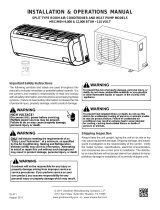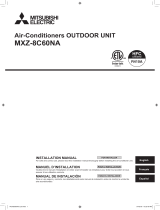
En-2
When Connecting Refrigerant Tubing
• Keep all tubing runs as short as possible.
• Use the brazing method for connecting tubing.
• Apply refrigeration compressor oil (or equivalent) used for the outdoor unit to the match-
ing surfaces of the flare and union tubes before connecting them, then tighten the nut
with a torque wrench for a leak free connection.
• Check carefully for leaks before starting the test run.
When Servicing...
• Turn the power OFF at the main circuit breaker panel before opening the unit to check or
repair electrical parts and wiring.
• Keep your fingers and clothing away from any moving parts.
• Clean up the site after you finish, remembering to check that no metal scraps or bits of
wiring have been left inside the unit being serviced.
• After installing the unit, perform a test run to make sure the unit operates normally. Then,
explain to the customer how to operate and maintain the unit.
• Please pass this Installation manual together with the Operating manual to the customer.
Please ask the customer to keep the Operating manual and Installation manual at hand
for future reference during the moving or repair of the main unit.
WARNING
For installation purposes, be sure to use the parts supplied by the manufacturer or other
prescribed parts.
Using non-specified parts will cause serious accidents such as falling unit, refrigerant
leakage, water leakage, electric shock, and fire.
To install a unit that uses the R410A refrigerant, use dedicated tools and piping materi-
als that have been manufactured specifically for R410A use.
Because the pressure of the R410A refrigerant is approximately 1.6 times higher than
the R22, failure to use dedicated piping material or improper installation can cause
rupture or injury.
It will also cause serious accidents such as refrigerant leakage, water leakage, electric
shock, and fire.
Do not introduce any substance other than the prescribed refrigerant into the refrigera-
tion cycle.
If air enters the refrigeration cycle, the pressure in the refrigeration cycle will become
abnormally high and cause the piping to rupture.
Ensure that the outdoor unit is securely installed at a place that can withstand the
weight of the unit.
Improper installation will cause injuries caused by falling unit.
If there is a refrigerant leakage, make sure that it does not exceed the concentration
limit.
If a refrigerant leakage exceeds the concentration limit, it can lead to accidents such as
oxygen starvation.
If a refrigerant leakage occurs during operation, immediately vacate the premises and
thoroughly ventilate the area.
If the refrigerant is exposed to fire, it will create a hazardous gas.
Electrical work must be performed in accordance with this Installation manual by a
person certified under the national or regional regulations. Be sure to use a dedicated
circuit for the unit.
For wiring, use the prescribed type of cables, connect them securely, making sure that
there are no external forces of the cables applied to the terminal connections.
Improperly connected or secured cables can cause serious accidents such as overheat-
ing the terminals, electric shock, or fire.
Do not turn ON the power until all work has been completed.
After the installation, make sure there is no refrigerant leakage.
If the refrigerant leaks into the room and becomes exposed to a source of fire such as a
fan heater, stove, or burner, it will create a hazardous gas.
Use a wall hole pipe. Otherwise, it may cause a short circuit.
Do not place the outdoor unit near the handrail of the balcony.
Children may climb onto the outdoor unit, lean over the handrail and fall over.
Use only a specified power cable. Poor connection, poor insulation, and exceeding the
allowable current will lead to electric shock and fire.
Install a breaker to cut off all AC main current at the same time.
If you do not install a breaker, it may cause electric shock and fire.
Be sure to install the refrigerant pipe before operating the compressor. If the refrigerant
pipe is not installed and you operate the compressor while the valve is open, air will be
sucked into the system and abnormal pressure will occur in the refrigerant cycle. This
will damage the unit and cause injuries.
During the pump-down operation, make sure that the compressor is turned off be-
fore you remove the refrigerant piping. Do not remove the connection pipe while the
compressor is in operation with 2-way or 3-way valve open. This may cause abnormal
pressure in the refrigeration cycle that leads to breakage and even injury.
If there is a possibility of touching the fan during maintenance, make sure to turn OFF
the power before implementing the maintenance. Even if operations are suspended,
the fan of outdoor unit sometimes rotates, so if the fan rotates suddenly while in contact
with you may cause serious injury.
Installation must be performed in accordance with the requirement of NEC (National
Electrical Code) and CEC (Canadian Electrical Code) by authorized personnel only.
Cancer and Reproductive Harm - www.P65Warnings.ca.gov
CAUTION
This unit must be installed by qualified personnel with a capacity certificate for handling
refrigerant fluids. Refer to regulation and laws in use on installation place.
The installation must be carried out in compliance with regulations in force in the place
of installation and the installation instructions of the manufacturer.
This unit is part of a set constituting an air conditioner. It must not be installed alone or
with non-authorized by the manufacturer.
This unit contains no user-serviceable parts. Always consult authorized service person-
nel to repairs.
When moving, consult authorized service personnel for disconnection and installation
of the unit.
• Obtain the distribution network operator's agreement about the power capacity of the
power supply system, specification of the cable and the harmonic current, and etc.
when you connect the outdoor unit with the power supply.
• This unit must be connected to a power supply with impedance of 0.398 ohm and
below. If the power supply does not satisfy this requirement, please consult the power
supplier.
• This product is intended for professional use.
Be sure to use a dedicated power circuit.
Never use a power supply shared by another appliance.
Do not install the unit in the following areas:
• Area with high salt content, such as at the seaside. It will deteriorate metal parts,
causing the parts to fail or the unit to leak water.
• Area filled with mineral oil or containing a large amount of splashed oil or steam, such
as a kitchen. It will deteriorate plastic parts, causing the parts to fail or the unit to leak
water.
• Area that generates substances that adversely affect the equipment, such as sulfuric
gas, chlorine gas, acid, or alkali. It will cause the copper pipes and brazed joints to
corrode, which can cause refrigerant leakage.
• Area containing equipment that generates electromagnetic interference. It will cause
the control system to malfunction, preventing the unit from operating normally.
• Area that can cause combustible gas to leak, contains suspended carbon fibers or
flammable dust, or volatile flammables such as paint thinner or gasoline. If gas leaks
and settles around the unit, it can cause a fire.
• Avoid installing the unit at places where it will come into contact with animals’ urine or
ammonia.
The units are not explosion proof and therefore should not be installed in explosive
atmosphere.
Do not use the unit for special purposes, such as storing food, raising animals, growing
plants, or preserving precision devices or art objects. It can degrade the quality of the
preserved or stored objects.
Perform draining for the unit according to the Installation manual. Check that the water
is properly drained. If the drain processing is improperly installed, water may drip down
from the unit, wetting the furniture.
Be sure not to start or stop the operation of air conditioning with power breaker. Other-
wise, it may cause malfunction or water leakage.
When setting it up near the equipment that generates electromagnetic waves and the
equipment that generates the higher harmonics wave, be sure to take measures against
noise. Otherwise, it may cause malfunction or failure.
When energizing to the crankcase heater, please turn on the power 12 hours or earlier
before operation begins. When the energizing time is short, it may cause failure. Be-
sides, please do not turn off power during the busy season.
Children should be monitored to ensure they do not play with the device.
This product is not intended to be used by people (including children) with physical,
sensory or mental disability, or persons lacking experience or knowledge unless they
have been given by the through a person responsible for their safety, supervision or
instruction concerning the use of the device.
2. ABOUT THIS PRODUCT
2.1. Precautions for using R410A refrigerant
Pay careful attention to the following points:
Since the working pressure is 1.6 times higher than that of R22 models, some of the
piping and installation and service tools are special. (See the table in the SPECIAL
TOOLS FOR R410A section.)
Especially, when replacing a conventional refrigerant (other than R410A) model with
a new refrigerant R410A model, always replace the conventional piping and flare nuts
with the R410A piping and flare nuts.
Models that use refrigerant R410A have a different charging port thread diameter to pre-
vent erroneous charging with R22, R407C and for safety. Therefore, check beforehand.
[The charging port thread diameter for R410A is 1/2 UNF 20 threads per inch.]
Be more careful than the installation of the refrigerant (other than R410A) models, not
to enter foreign matters (oil, water, etc.) and other refrigerant into the piping. Also, when
storing the piping, securely seal the openings by pinching, taping, etc.
When charging the refrigerant, take into account the slight change in the composition
of the gas and liquid phases, and always charge from the liquid phase side whose
composition is stable.



















